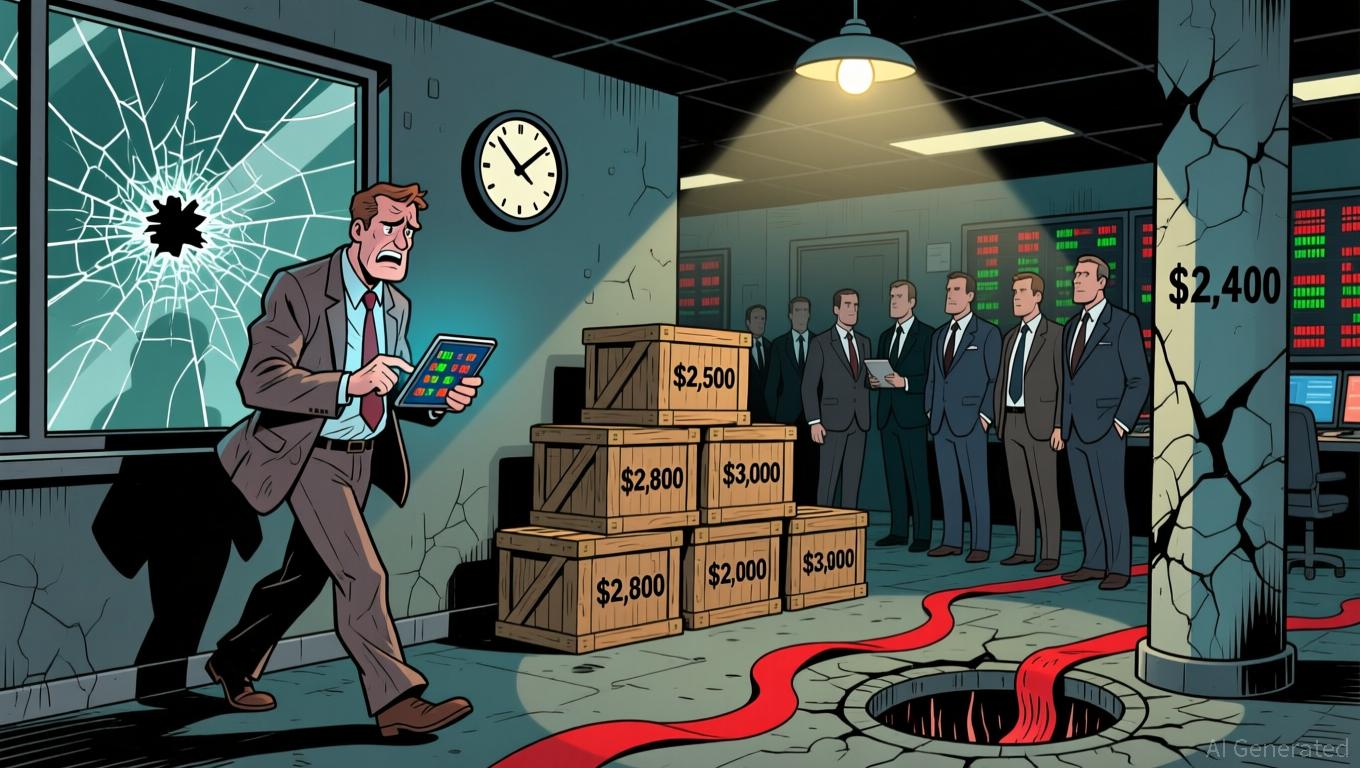Zcash Halving: What It Means for Cryptocurrency Investors
- Zcash's Nov 6, 2025 halving cut block rewards by 50%, sparking a 1,172% YTD price surge to $589. - Deflationary supply mechanics and 30% shielded liquidity via zk-SNARKs amplify volatility while masking tradable supply. - Institutional adoption (Grayscale, Reliance) and regulatory clarity (Clarity Act) boost Zcash's legitimacy as "stealth Bitcoin ." - Future challenges include 2028 halving, regulatory scrutiny of privacy features, and competition from emerging protocols.
Zcash Halving 2025: Impact and Market Evolution
On November 6, 2025, Zcash (ZEC) underwent its third halving event, a significant milestone for the privacy-centric cryptocurrency. This process halved the block reward, sparking a remarkable 1,172% year-to-date price increase, with ZEC reaching $589. The event has heightened attention on how limited supply and growing institutional involvement are shaping Zcash’s price trajectory. For those investing in ZEC, it’s essential to grasp the complex relationship between its deflationary design, privacy technology, and shifting regulatory environment.
Supply Constraints and Price Volatility
The 2025 halving reduced Zcash’s block reward from 3.125 ZEC to 1.5625 ZEC per block, bringing annual inflation down to about 4%. This mirrors Bitcoin’s scarcity approach but is further complicated by Zcash’s dual-address system, which lets users opt for either transparent or shielded transactions using advanced zero-knowledge proofs (zk-SNARKs). By late 2025, between 28% and 30% of all ZEC was held in shielded addresses, highlighting increased demand for privacy and reducing the amount of ZEC visible on-chain.
This dual system creates a unique market dynamic: while lower issuance increases scarcity, shielded transactions obscure the actual circulating supply, which can distort price signals and heighten volatility. Historical trends reinforce this pattern—after the 2020 halving, ZEC climbed 500%, and the 2024 halving was followed by a 92% surge in the last quarter of that year. The 2025 halving triggered an extraordinary 24% single-day jump to $641.49, followed by a 35% pullback, illustrating the influence of speculation and institutional entry on price swings.
Institutional Adoption and Regulatory Developments
Institutional interest has played a pivotal role in Zcash’s recent growth. The Grayscale Zcash Trust, which oversees $137 million in assets, has become a major vehicle for institutional exposure. Cypherpunk Technologies acquired 5% of the total ZEC supply, and Reliance Global Group shifted its entire digital asset holdings into ZEC, citing its privacy features that are compatible with regulatory requirements. Zcash’s partial move to a proof-of-stake model in October 2025 also aligned it with ESG (Environmental, Social, and Governance) standards, attracting sustainability-minded investors.
Clearer regulatory guidelines have further strengthened market confidence. The U.S. Clarity Act and Genius Act established a legal foundation for privacy coins, while Grayscale’s proposal for a Zcash ETF (ticker: ZCSH) signaled growing institutional appetite for regulated investment products. Zcash’s relisting on OKX, following a previous delisting, coincided with a 1,200% price rally, reflecting improved acceptance. Nonetheless, European regulators remain wary, and new anti-money laundering rules could pose delisting risks, highlighting regional differences in regulatory approaches.
Shielded Transactions and Market Structure
The rise of shielded ZEC holdings—now totaling 4.9 million coins, or 30% of the supply—has prompted institutions to rethink their trading strategies. The preference for selective privacy, fueled by advances in zero-knowledge technology and ongoing regulatory uncertainty, has reduced the amount of ZEC available for transparent trading. This shift has forced institutions to adapt to a market with less visible liquidity. Notably, Arthur Hayes’ endorsement of “shielded liquidity” strategies has driven a 560% increase in fee revenue and reshaped market behavior.

For investors, these changes mean that Zcash’s price is now influenced not only by supply reductions but also by the balance between shielded and transparent transactions. This complexity introduces both new opportunities and risks, as institutions weigh the benefits of privacy against the challenges of reduced tradability.
Looking Ahead: Opportunities and Obstacles
The next halving, anticipated in late 2028, will further decrease block rewards to 0.78125 ZEC, tightening supply even more and potentially supporting price stability. However, Zcash must navigate ongoing regulatory scrutiny of shielded transactions and competition from new privacy-focused cryptocurrencies. Institutional investors will need to consider these challenges alongside Zcash’s core advantages of limited supply and robust privacy features.
At present, Zcash’s post-halving performance points to a maturing asset. As institutional demand grows and regulatory clarity improves, ZEC may increasingly be viewed as a “stealth Bitcoin”—offering a distinctive combination of scarcity, privacy, and institutional-grade infrastructure.
Disclaimer: The content of this article solely reflects the author's opinion and does not represent the platform in any capacity. This article is not intended to serve as a reference for making investment decisions.
You may also like
XRP News Today: Abu Dhabi’s Green Light Establishes UAE as a Pioneer in Stablecoin Development
- Ripple's RLUSD stablecoin gains Abu Dhabi regulatory approval as UAE advances digital finance leadership. - ADGM's "Accepted Fiat-Referenced Token" designation enables institutional use for lending and cross-border payments. - RLUSD's $1.2B market cap growth reflects institutional demand, backed by USD reserves and dual blockchain operations. - UAE's ADGM-DIFC regulatory synergy attracts global fintechs , with Ripple expanding partnerships across Africa and Asia. - Regulatory milestones position RLUSD to
Ethereum Updates: Ethereum Drops to $2,800, Prompting Surge in Demand for ZKP's Hardware-Based Presale
- Ethereum's price fell below $2,800, triggering $6.5M liquidations and testing critical support levels amid declining on-chain demand metrics. - Institutional players like BitMine accumulated 3.62M ETH (~$10.4B) despite the selloff, signaling long-term bullish conviction. - ZKP's hardware-driven presale gained traction with $17M in ready-to-ship Proof Pods and Miami Dolphins partnership for privacy-focused sports analytics. - Mutuum Finance's $19M DeFi presale and ZKP's auction model with $50K wallet caps

Vitalik Buterin Supports ZKsync: What This Means for Layer 2 Scaling
- Vitalik Buterin endorsed ZKsync in late 2025, highlighting its "underrated and valuable" work alongside the Atlas upgrade achieving 15,000 TPS and $0.0001 fees. - ZKsync's zero-knowledge rollups and EVM compatibility enabled institutional adoption by Deutsche Bank , Sony , and Goldman Sachs for cross-chain and enterprise use cases. - The Fusaka upgrade aims to double throughput to 30,000 TPS by December 2025, positioning ZKsync to compete with Polygon zkEVM and StarkNet in Ethereum's Layer 2 landscape. -

The ZK Atlas Enhancement: Revolutionizing Blockchain Scalability?
- ZKsync's 2025 Atlas Upgrade achieves 15,000–43,000 TPS with sub-1-second finality, addressing Ethereum L2 scalability bottlenecks via Airbender proofs and modular OS. - DeFi protocols like Aave and Lido leverage ZKsync's $0.0001/tx costs to unify liquidity, while Deutsche Bank and Sony adopt its trustless cross-chain infrastructure for compliance and transparency. - ZK token surged 150% post-upgrade, with TVL hitting $3.3B and analysts projecting 60.7% CAGR for ZK Layer-2 solutions by 2031 amid instituti
